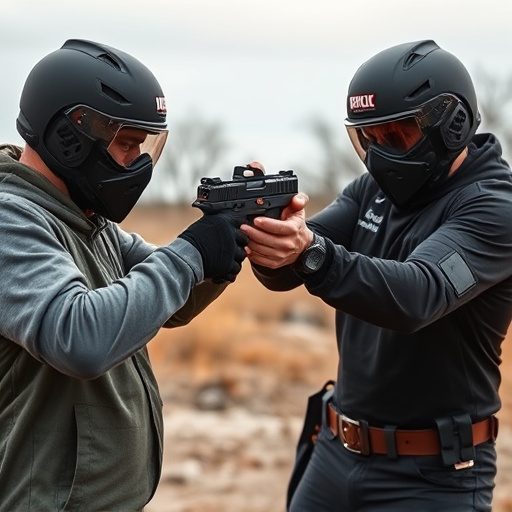Compact Stun Guns’ Current Spread: Analysis for Enhanced Safety
TL;DR: Understanding electrical current spread in compact stun guns with flashlights is vital for ba…….
TL;DR: Understanding electrical current spread in compact stun guns with flashlights is vital for balancing performance and safety. Researchers use advanced tools like high-speed cameras and simulations to analyze current flow, identify bottlenecks, and predict potential risks. By interpreting these patterns, engineers can optimize energy distribution, enhance efficiency, and ensure safe operation of compact stun guns. This data-driven approach leads to improved design, making these devices more reliable, compact, and effective for personal safety while mitigating risks associated with uneven current leakage.
Electrical current spread patterns, especially in compact stun guns with integrated flashlights, offer critical insights into device performance and safety. Understanding how current flows through these devices is crucial for enhancing their effectiveness and mitigating risks. This article delves into the foundational concepts of electrical current spread analysis, explores unique challenges posed by compact stun guns with flashlights, outlines observation and measurement methods, interprets data implications, and discusses practical applications that can revolutionize safety measures.
- Understanding Electrical Current Spread: A Foundation for Analysis
- Compact Stun Guns with Flashlight: Unique Challenges and Considerations
- Methods for Observing and Measuring Current Spread Patterns
- Interpreting Data: What Do the Patterns Reveal?
- Applications and Implications: Enhancing Safety with Knowledge
Understanding Electrical Current Spread: A Foundation for Analysis

Understanding Electrical current spread is a fundamental aspect of analyzing how electricity flows and interacts within various systems, especially in compact stun guns with flashlights. This analysis provides crucial insights into the device’s performance, safety, and design implications. By studying the pattern of current flow, engineers can optimize power distribution, ensure efficient energy transfer to the flashlight, and guarantee the safe operation of the stun gun component.
The spread of electrical current is influenced by factors such as conductivity, resistance, and the presence of various materials in the device’s structure. In compact stun guns, for instance, understanding how current flows through the circuit board, conductive paths, and ultimately to the electrodes can help identify potential bottlenecks or inefficiencies. This knowledge is vital for enhancing overall performance while maintaining safety standards, particularly when integrating powerful components like flashlights into such compact devices.
Compact Stun Guns with Flashlight: Unique Challenges and Considerations

Compact stun guns with integrated flashlights present unique challenges and considerations for electrical current spread pattern analysis. These devices, designed for portability and versatility, offer a compact solution for personal safety. However, their small size can make it more difficult to accurately determine the path and intensity of the electrical current, as it interacts with the human body. The flashlight component adds another layer of complexity, as light and electricity can interfere with each other, potentially affecting the reliability of current spread data.
Moreover, compact stun guns often have limited battery life, which necessitates a more efficient energy distribution system to ensure optimal performance. This requires a detailed understanding of how the electrical current flows through various materials, including body tissues, to maximize the device’s effectiveness while minimizing risks associated with excessive current leakage or uneven distribution. Researchers and designers must carefully consider these factors to develop safe and effective compact stun guns with flashlight functionality.
Methods for Observing and Measuring Current Spread Patterns

The analysis of electrical current spread patterns is crucial for understanding how energy flows through various materials, particularly in compact stun guns with integrated flashlights. Observing these patterns requires specialized techniques to capture and visualize the dynamic behavior of electricity. One common method involves using advanced imaging technologies like high-speed cameras and thermal imaging sensors. These tools can capture detailed images of current flow, revealing hotspots and areas of intense activity, which are essential for safety and performance optimization in stun gun design.
Additionally, computational simulations play a vital role in modeling and predicting current spread patterns. By inputting material properties and geometric configurations, researchers can simulate the behavior of electrical current within a stun gun’s components, including the flashlight module. This approach allows for fine-tuning designs, ensuring optimal energy distribution and efficiency while also identifying potential vulnerabilities or areas prone to excessive current concentration, enhancing overall safety measures.
Interpreting Data: What Do the Patterns Reveal?

Interpreting Data: Unveiling Insights from Spread Patterns
When analyzing electrical current spread patterns, especially in compact stun guns with integrated flashlights, data interpretation is key to understanding device performance and safety. Each pattern reveals crucial information about energy distribution, helping experts identify potential risks or advantages. For instance, a uniform current spread suggests optimal energy transfer, ensuring consistent stun effectiveness. Conversely, concentrated hotspots could indicate areas of excessive current density, potentially leading to localized damage or overheating issues.
By studying these patterns, researchers can make informed decisions about design improvements. Optimizing the arrangement and material properties of internal components based on data insights can enhance overall device performance and safety. Moreover, understanding how current interacts with various materials inside the stun gun enables engineers to create more compact, efficient, and reliable devices, such as those featuring advanced flashlights that illuminate potential hazards during use.
Applications and Implications: Enhancing Safety with Knowledge

The applications of electrical current spread pattern analysis extend beyond academic research, offering significant implications for enhancing safety in everyday contexts. By understanding how electricity flows and spreads through various materials, we can develop innovative solutions to mitigate risks associated with electrical devices. For instance, this knowledge is pivotal in designing safer compact stun guns with integrated flashlights, where precise control over current distribution can enhance both effectiveness and user safety.
Improvements in current pattern analysis enable manufacturers to optimize the design of such devices, ensuring that energy is delivered efficiently while minimizing potential hazards. This research empowers individuals to make informed choices, especially when carrying personal protection equipment like compact stun guns, by providing insights into the device’s performance and safety features.
The analysis of electrical current spread patterns, particularly in compact stun guns with integrated flashlights, offers crucial insights into device performance and safety. By understanding how current flows through these innovative tools, manufacturers can optimize design, enhance efficiency, and ultimately improve user safety. Through advanced measurement methods and data interpretation, the potential risks associated with compact stun guns are minimized, ensuring they remain effective personal safety devices. This knowledge-driven approach, highlighted in this analysis, is a game-changer for the industry, fostering responsible innovation in the realm of compact self-defense tools.


